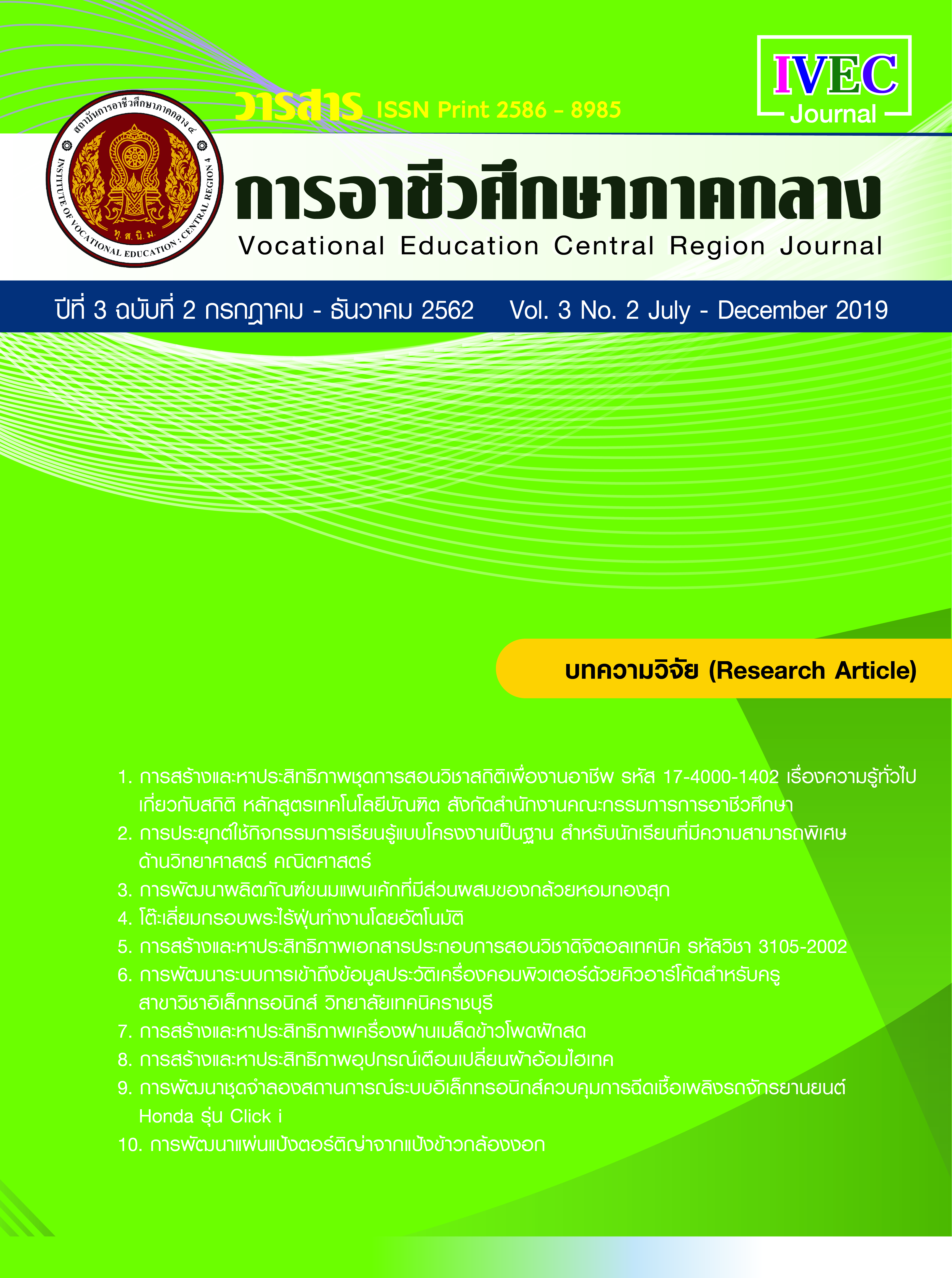The Development of Flour Tortilla from Germinated Brown Rice Flour
Main Article Content
Abstract
The research objectives were: 1) To study the basic recipe for the flour tortilla and appropriate amount of germinate brown rice in the flour tortilla with a different amount of germinated brown rice flour at the ratio of 0% (control recipe), 10%, 20% and 30% by weight of flour. 2) To study the color (L* a* and b*) of the flour tortilla from germinated brown rice flour. 3) To study the nutrients of the flour tortilla from germinated brown rice flour. The sensory quality test of the flour tortilla from germinated brown rice flour by giving 9-Point Hedonic Scale Test, by 50 testers were tested and found that substitution wheat with 20% germinated brown rice flour exhibited similar acceptability of control (p≤0.05). It received the highest ratings for color, smell, taste and texture. Which the tortilla flakes are brown Soft and chewy texture. The flour tortilla has brown color, the texture has sticky and soft, the fragrance of germinated brown rice flour. Color of flour tortilla from 20% germinated brown rice flour found that L* a* and b* were 54.53, 9.28 and 27.09 respectively. Increased levels of germinated brown rice flour, L* value was decrease but a* and b* value increase. The results of the nutrition of flour tortilla from 20% germinated brown rice flour (100 g) has Energy 1,827.39 Kcal, Fat 64.38 g Protein 34.70 g, Carbohydrate 272.01 g and fiber 11.23 g.
Article Details
|
บทความ ข้อมูล เนื้อหา รูปภาพ ฯลฯ ที่ได้รับการตีพิมพ์ในวารสาร การอาชีวศึกษาภาคกลาง ถือเป็นลิขสิทธิ์ของวารสารการอาชีวศึกษาภาคกลางหากบุคคลหรือหน่วยงานใดต้องการนำทั้งหมดหรือส่วนใดส่วนหนึ่ง ไปเผยแพร่ต่อหรือเพื่อกระทำการใด ๆ กองบรรณาธิการไม่สงวนสิทธิ์ ในการคัดลอกบทความเพื่อการศึกษาแต่ให้อ้างอิงแหล่งที่มาให้ครบถ้วน สมบูรณ์ สงวนสิทธิ์ โดย สถาบันการอาชีวศึกษาภาคกลาง 4 ที่ตั้ง 90 ถนนเทศา ตำบลพระปฐมเจดีย์ อำเภอเมือง จังหวัดนครปฐม โทรศัพท์ 034 242 856 , โทรสาร 034 242 858 ISSN : 3056-9176 (print) ISSN : 2985-2382 (online) |
References
2. วรรณดาลักษณ์ เสตสุวรรณ. (2559). ตอร์ติญ่าชีส 5 ชนิด (5 CHEESES TORTILLAS). ค้นเมื่อ สิงหาคม 30, 2561,จาก http://www.thairath.co.th/ lifestyle/food/recipefood/598356.
3. วลาวัณย์ ทวีผดุง. (2559). ปัจจัยที่ส่งผลต่อความพึงพอใจในการใช้บริการร้านอาหารจานด่วนเคเอฟซีของผู้บริโภคในเขตกรุงเทพมหานครและปริมณฑล. การค้นคว้าอิสระบริหารธุรกิจมหาบัณฑิต คณะพณิชยศาสตร์แลพการบัญชีมหาวิทยาลัยธรรมศาสตร์.
4. แสงโสม สีนะวัฒน์. (2554). ตำรับอาหารจากข้าวกล้อง. พิมพ์ครั้งที่ 5. ม.ป.ท.: ม.ป.พ.
5. อภิญญา เจริญกูล. (2556, (พิเศษ) พฤษภาคม-สิงหาคม). ผลของการทดแทนแป้งสาลีด้วยแป้งข้าวกล้องงอกต่อคุณภาพของมัฟฟิน. วิทยาศาสตร์การเกษตร, 44 (2 พิเศษ), หน้า 237-240.
6. Chamber IV, E. and M.B. Wolf. (1996). Sensory testing methods. (2nd ed.). Philadelphia USA: American Society for Testing and Materials.
7. H.J. Chung, A. and Cho, S.T. Lim. (2012). Effect of heat-moisture treatment for utilization of germinated brown rice in wheat noodle. Food Science and Technology, 47 (2), pp. 342-347.
8. L.W. Rooney R. Waniska C.M. McDonough S.O. Serna-Saldivar. (2004). Tortillas. Encyclopedia of GrainScience. pp. 290-298.
9. Nasa-Abbas,S.M.and Jayasena, V. (2012). Effect of lupin flour incorporation on the physical and sensory properties of muffins. Quality Assurance and Safety of Cropsand Foods. 41 (1), pp. 41-49.
10. Natalya drozhzhin. (2015). Totilla. Retrieved August 30, 2015, form http://momsdish.com.
11. Sistacafe. (2016). Totilla. Retrieved August 30, 2015, form : http://momsdish.com.
12. Watanabe M., Maeda T., Tsukshsrsa K., Ksyahara H. and Morita N. (2004). Application of pregerminated brown rice for breadmaking. Cereal Chem, 81 (4), pp. 450-455.


